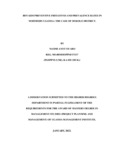HIV/AIDS preventive initiatives and prevalence rates in northern Uganda: the case of Dokolo district.
Abstract
The study assessed the effectiveness of HIV/AIDS preventive initiatives in
reducing HIV/AIDS prevalence in Dokolo district from the year 2006 to 2010 when
Dokolo was formalized as a district. The study had the following specific outputs;
i) It established the effect of Prevention of Mother to Child Transmission (PMTCT)
on HIV/AIDS prevalence in Dokolo; ii) It determined the effect of HIV/AIDS
counseling and Testing (HCT) on HIV/AIDS prevalence in Dokolo; iii) It
established the effect of HIV/AIDS behavior change initiatives on HIV/AIDS
prevalence in Dokolo district and; iv) It found out the effect of economic factors on
HIV/AIDS prevalence in Dokolo District.
A cross-sectional survey study design was used. Data was obtained through
questioning, in-depth interviews, observation, focus group discussions and
document reviewing. A total of 132 participants took part in the study and findings
revealed that PMTCT, HCT, HIV/AIDS behavior change initiatives (ABCD) and
economic factors were contributing to the variations in HIV/AIDS prevalence in
Dokolo district as all of them were statistically significant. Findings revealed that
HIV/AIDS prevalence rate can be reduced if community members in the district
change their current negative behaviors by adopting positive ones which reduce on
the spread of HIV, facilities, resources and technical skills amidst sound relations
between and among the various stakeholders involved in the fight against the
epidemic should also be available throughout for success. It is recommended that;
1) for success in reduction of HIV prevalence rate in the district, communities
should be sensitized and mobilized for active participation; 2) Preventive initiatives should be provided in a logical combination for example if HCT is being provided,
PMTCT services should also be present and/or other economic services so as to
enhance a positive attitude towards the HIV/AIDS preventive initiatives and;
3)Economic support of the already infected people is necessary so as to motivate
positive living thus reducing the spread and therefore HIV/AIDS prevalence in
Dokolo District. Other factors not explained by this research should be explored as
well to determine how they affect project performance.
In conclusion, this study revealed that HIV Testing and Counseling has the greatest
impact on HIV/AIDS prevalence in terms of either reducing its prevalence when
the HCT services are readily available and accessible and the opposite is true. The
study also revealed that the second most influencing factor is economic
environment then behavioral change strategies (ABCD Model) then lastly
Prevention of Mother to Child Transmission of HIV/AIDS(PMTCT) which has
quite an insignificant effect on HIV/AIDS prevalence. It should also be noted that
PMTCT could be effective if it is readily available and accessible.
The lesson learned in this study therefore is that HIV/AIDS service providers
should put more emphasis on HCT as the major step to preventing the increasing
prevalence of HIV/AIDS particularly in Northern Uganda. This should be in
combination with other factors that also influence HIV/AIDS if we are to succeed
in fighting the increasing HIV/AIDS prevalence.

